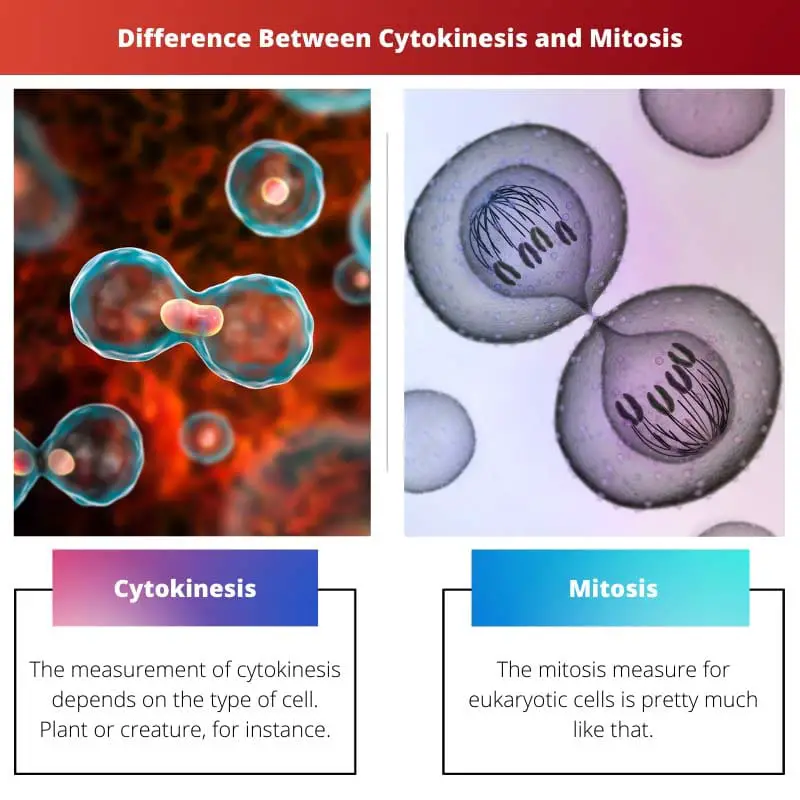Cells are life’s ultimate “building blocks.” You are small yet have each essential property involving life, including digestion and proliferation.
Key Takeaways
- Mitosis is the process of cell division that results in two identical daughter cells. In comparison, cytokinesis is the process of cell division that separates the cytoplasm of a single cell into two daughter cells.
- Mitosis involves the division of the nucleus, while cytokinesis involves the division of the cytoplasm.
- Mitosis is important for the growth and repair of body tissues, while cytokinesis is necessary for the completion of cell division.
Cytokinesis vs Mitosis
Mitosis divides the nucleus and duplicates chromosomes, resulting in two identical hearts in each daughter cell. Cytokinesis, on the other hand, is the process of dividing the cytoplasm and cell membrane to separate the two daughter cells physically. Cytokinesis co-occurs with the final stages of mitosis and forms two genetically identical daughter cells, each with its nucleus and cytoplasm.

Cytokinesis happens any time karyokinesis. Cytokinesis occurs through two fundamental processes: animals and other eukaryotic cells and one through plant cells—the cytoplasm of a telephone into two during cytokinesis.
Mitosis is a cell replication or replication process that leads to two genetically identical daughter cells in one cell. Strictly applied to the term mitosis, the mechanisms that include the genetic material explain the replication and distribution of chromosomes.
Comparison Table
| Parameters of Comparison | Cytokinesis | Mitosis |
|---|---|---|
| Training Event | The measurement of cytokinesis depends on the cell type — plant or creature, for instance. | The mitosis measure for eukaryotic cells is pretty much like that. |
| Nuclei | Two cells are enveloped by cytokinesis. | Mitosis generates two nuclei. |
| Karyokinesis | After karyokinesis, cytokinesis involves a cytoplasm separation. | Mitosis includes karyokinesis only. |
| Process Application | During mitosis, cytokinesis occurs. | Until cytokinesis, mitosis occurs. |
| Removal | Specific cell organelles and cytoplasms are cytokineses. | Mitosis is only inherited through heritage. |
| Separated equity | Organelle division is not essentially equal during cytokinesis. Cell size ranges from time to time as well. | Two identical chromosome structures are separated into two cells during mitosis. |
What is Cytokinesis?
Cytokinesis is the last cell-division interaction in which maternal cytoplasms separate two parts by isolating cytoplasmic organs and copying genomes to form the framework of two girls’ cells. It begins in late anaphase, passes through telophase and ends sometime after the transition of nuclear film in the girl’s heart.
A ‘contractile loop,’ consisting of a ring of proteins, including contractile collections of filamentous protein actin and engine protein myosin II, begins with cleaved wrinkles within animal cells. The contractile ring covers the phone equator below the phone cortex, and the chromosome separation centre is divided.
Plant cells have a wooden cell divider, as opposed to creature cells. In comparison, cytokinesis in plants and creatures takes place along these lines.
The cell plate outwards, and wires shape two new small girl’s cells across the plasma membrane. The new plasma plate, framing the new two-cell dividers, is set up with cellulose.
What is Mitosis?
Mitosis is a dynamic, thoroughly directed loop occurring in eukaryotes alone. This relationship is also the breakthrough in the two genomes’ partition.
Mitosis takes about two hours – from the prophase to the telophase. Initially, during the prophase, mitotic contraction is formed.
Chromosomes bind to the axle during prometaphase. In metaphase, chromosomes change at the cell equator, and subsequently, in anaphase, chromatids differentiate each other by dividing the centromeres.
Finally, the transition of the nuclear envelopes occurs in two shafts with the framing of female nuclei. In this way, this essentially completes the atomic separation.

Main Differences Between Cytokinesis and Mitosis
- Mitosis refers to a cell centre division into two, whereas cytokinesis refers to the further breakdown of the cell cytoplasm that forms two girl cells.
- Specific cell organelles and cytoplasms are cytokinesis, whereas mitosis is only inherited through heritage.
- Organelle division is not essentially equal during cytokinesis. Cell size also ranges occasionally, whereas two identical chromosome structures are separated into two cells during mitosis.
- Mitosis is the nucleus division, while cytokinesis is the cytoplasm division. There are two phases of the cell cycle.
- Mitosis causes new cells to grow and improve, whereas cytokinesis ensures that chromosome numbers are in cells.




